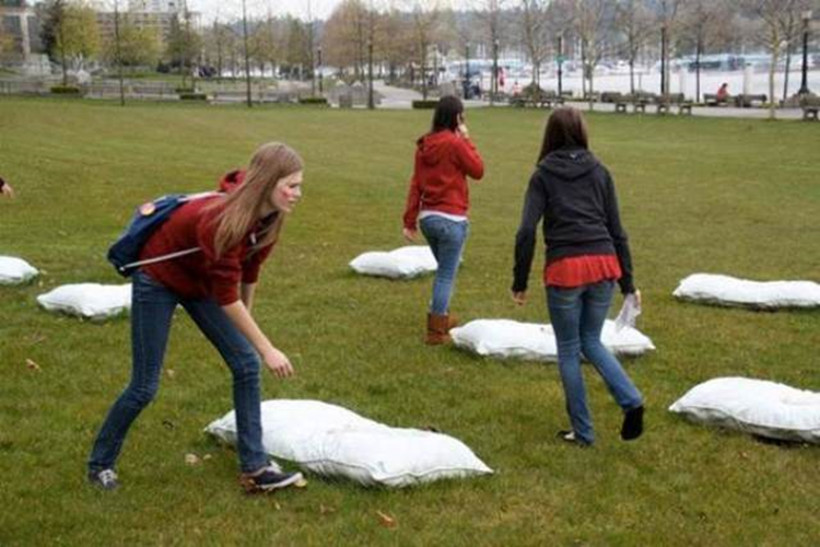Pillows
Arts Education, Physical Education, Social Studies
Sculpture Title:
Pillows
Learning Lens:
Health and Social Education
Curriculum Access:
Socials Studies, Physical Education, and Arts
BIG IDEA:
How homelessness impacts individuals and society
Guiding Question:
Does awareness of an issue create advocacy and change?
Strategies and Approaches:
Teamwork; Socratic Questioning; informal assessment, prompting, drama exercises; experiential learning; critical thinking; information gathering
Background for Students:
Homelessness refers to people who lack housing for a variety of reasons or are otherwise unable to maintain, regular, safe and adequate shelter. For many, a primary nighttime residence can be in a homeless shelter, couch surfing with friends, or on the streets. Housing is a major issue in the Downtown Eastside and within the Vancouver area. Many of the hotels that have historically provided modest, affordable rooms are being torn down, left to deteriorate into unlivable slums, or converted into higher priced housing. Many tenants are unaware of their rights which can lead to many violations of their living standards and possible eviction. Government social services and community activists work towards providing people that face homelessness or the risk of no shelter with supportive housing strategies. The main cause of homelessness is a lack of affordable housing. In addition, low income and unemployment are significant factors in an individual becoming and remaining homeless. Drug addiction and mental illness are also a significant impact on stable health. These individuals are extremely difficult to house outside of supported living.
Informal Assessment:
Through discussion, ensure students form an expanded meaning of a ‘home.’ Encourage them to think about their concepts and the larger issues of homelessness within their community. Have them think about the multiple causes that can lead to homelessness, ranging from broken homes, at risk youth to mental illness. Look for evidence that students feel compassion and empathy for people living in poverty. Compare their lives to those living in poverty, acknowledging the privilege in their lives. Encourage suggestions on ways they can change their attitudes or practices, exhibiting a desire to help and learn from those living in poverty demonstrating and caring and compassion towards their peers
Materials:
Ziploc bags with info strips (see below), poster paper, markers, and clues for role play (see below)
Curricular Challenge:
15-20 mins, Open/Reflect: Welcoming Multiple Interpretations
1. Students are encouraged to disengage from their recent experience and their busy surroundings to practice mindfulness.
2. Direct students to ‘mindfully’ (quietly/individually) explore the piece and develop their own interpretation.
* More information on mindfulness for the classroom can be found here.
3. Direct each student to share their interpretation of the piece without judgement.
4. Connect students’ individual interpretations to the background information provided above.
30 mins, Challenge
- As a group, the students are to search for the info strips hidden amongst the pillows (info strips below).
- After they have all been found each member takes a turn reading out the information. Discuss the
- piece of information and have students think about how it relates to their lived experience.
Info Strips:
The Downtown Eastside has been called the ‘poorest postal code in Canada’ as it has very high rates of poverty, as well as drug addiction, prostitution and crime rates.
The UN indicates that the Downtown Eastside is home to a Hepatitis C rate of 70% and an HIV rate of 30% the same as Botswana’s.
In 2008, Metro Vancouver’s initial homeless count found 2,592 people sleeping on the street without a home.
Since 2002, the number of social service providers has tripled in Vancouver due to low income housing units’ rising rental rates.
Until the mid 1980s East Hastings was the core shopping area of the city.
Lack of government funding led to deinstitutionalization of mental health patients, many of whom found their way to the Downtown Eastside.
67% of Vancouver’s Residents identified homelessness as their greatest concern.
Homelessness in Vancouver has nearly doubled between 2005-2010.
15 mins, Challenge 2:
- Each student is given an identity that is taped to their back so that they cannot see it (see below).
- Have students silently walk around and think about the stereotypes that might be associated with these labels.
- After a few minutes students whisper these stereotypes to labelled peers.
- Invite peers to guess their own label.
- Debrief: encourage students to think about false or general beliefs about groups of people that may ignore their individual and unique differences of people.
Labels: Elderly person, teenage girl, beggar, old man, mentally ill, drug addicted, homeless, depressed
15 mins, Challenge 3:
- On poster paper have students represent their recent experience with the activity by creating an advocacy poster. Prompt them to think about: What does it mean to have a home? What does it mean to be homeless? Why do you think some people are homeless? How do you react to people living in the Downtown Eastside?
Debrief: Ask students to consider the following: are most people living on the street because they want to? What are some of the reasons they have ended up on the street? What needs to change in order for the homeless crisis to be addressed?
